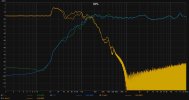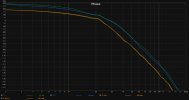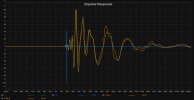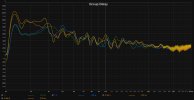It does look a lot like what an IIR filter would do as far as Group Delay goes. I know you can use Rephase to create a FIR "Linerize" filter for a 120 Hz 24 dB per Octave Low Pass filter which should correct the sub Group Delay but not sure how it would work (or how you would apply it) if you applied it just to the sub output since FIR filters add latency. If you could figure out a way to both apply the FIR linearize filter to the subs and then re-adjust the sub to mains timing it may give you what you want.
I tried to manually apply a delay and redo the calibration.
I was able to solve the artifact problems using the plugin instead of the standalone processor fortunately.
So, I applied exactly 75ms of delay to mains, create the filter with same target as previous one, and then redo the REW measurements with appropriate timing ref.
The result was terrible in my opinion.
Dirac has applied 151ms of delay to subs, according to the processor indication (it is not clear to me why there is only one value if there are two subs ... each should have its own value).
Despite this, the subs were with the same GD as the old filter, while the mains showed over 220ms of delay.
Inexplicable honestly...
But not only that, I saw that by moving the crossover and putting it back to the exact same place, it is possible that a different filter is calculated.
I had reported this to technical support and they provided me with an explanation that is not very technical but according to which it is natural ...
I don't know, this bass control is starting to get tired.
I can't wait to see if ART will work properly. Its technology is unique and I hope it works.




